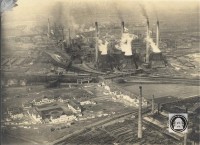"Interessengemeinschaft Farbenindustrie AG (German for ''Dye industry syndicate stock corporation''), commonly known as IG Farben (German for "IG Color"), was a German chemical and pharmaceutical conglomerate. Formed in 1925 from a merger of six chemical companies—BASF, Bayer, Hoechst, Agfa, Chemische Fabrik Griesheim-Elektron, and Chemische Fabrik vorm. Weiler Ter Meer—it was seized by the Allies after World War II and divided back into its constituent companies.[a]
In its heyday, IG Farben was the largest company in Europe and the largest chemical and pharmaceutical company in the world. IG Farben scientists made fundamental contributions to all areas of chemistry and the pharmaceutical industry. Otto Bayer discovered the polyaddition for the synthesis of polyurethane in 1937, and three company scientists became Nobel laureates: Carl Bosch and Friedrich Bergius in 1931 "for their contributions to the invention and development of chemical high pressure methods", and Gerhard Domagk in 1939 "for the discovery of the antibacterial effects of prontosil"." - (en.wikipedia.org 10.08.2021)
en





